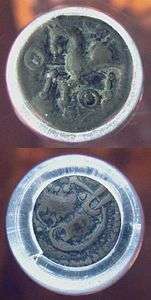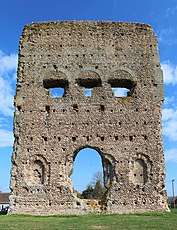Aedui
The Aedui, Haedui, or Hedui (Gaulish: "the ardent ones"; Ancient Greek: Αἰδούοι) were a Gallic tribe, dwelling in the modern Burgundy region during the La Tène and Roman periods.[1] According to Julius Caesar in his writings on the Gallic Wars in Commentarii de Bello Gallico, the Aedui were one of the stronger gallic tribes, them being the target of jealous tribes like the Helvetii, Sequani, Remi, and Arverni. Furthermore, the Aedui seemed to work in a semi-republican state, with the powerful Vergobret at least slightly being at the will of the people, similar to the senators of Rome [2]
The Aedui had an ambiguous relationship with the Roman Republic and other Gallic tribes. In 121 BC, they appealed to Rome against the Arverni and Allobroges. During the Gallic Wars (58–50 BC), they gave valuable though not whole-hearted support to Caesar, before eventually giving lukewarm support to Vercingetorix in 52.[1]
Name
They are mentioned as Ardues (Ἄρδυες) by Polybius (2nd c. BC),[3] as Haedui by Cicero (mid-1st c. BC) and Caesar (mid-1st c. BC),[4][5] as Haeduos by Livy (early 1st c. BC),[6] as Aedui by Pliny (1st c. AD),[7] as Aidúōn (Αἰδύων) by Ptolemy (2nd c. AD),[8] and as Aídouoi (Aἴδουοι) by Cassius Dio (3rd c. AD).[9][10]
The name Aedui ('the ardent ones') stems from Gaulish aidu- ('fire, ardour'), itself from Proto-Celtic *aydu- ('fire'; compare with Old Irish áed, Welsh aidd 'ardour'), ultimately from Proto-Indo-European *h₂eydʰos ('firewood'; compare with Sanskrit édhas 'bonfire', Latin aedes 'building, temple').[11][12]
Geography
Territory
The territory of the Aedui was situated in a strategic economic position between the Saône and Loire rivers, and included most of the modern départements of Saône-et-Loire and Nièvre, the southwestern-part of Côte-d'Or between Beaune and Saulieu, and the southern part of Yonne around Avallon,[13] corresponding to the Saône plains, the Morvan granitic massif, and the low Nivernais plateau, from east to west.[14] They dwelled between the Arverni in the west, the Segusiavi and Ambarri in the south, the Sequani in the east, and the Lingones and Senones in the north.[15]
Settlements
Three oppida are known from the late La Tène period: Vieux-Dun (Dun-les-Places), Le Fou de Verdun (Lavault-de-Frétoy), and Bibracte, which occupied a central position in the Aedian economic system.[16]
Ancient sources
The country of the Aedui is defined by reports of them in ancient writings. The upper Liger formed their western border,[17] separating them from the Bituriges. The Arar formed their eastern border, separating them from the Sequani.[18] The Sequani did not reside in the region of the confluence of the Dubis and the Arar, and of the Arar into the Rhodanus, as Caesar says that the Helvetii, traveling southward along the pass between the Jura Mountains and the Rhodanus, which belonged to the Sequani, plundered the territory of the Aedui.[19] These circumstances explain an apparent contradiction in Strabo, who in one sentence says that the Aedui lived between the Arar and the Dubis, and in the next, that the Sequani lived across the Arar (eastward).[20] Both statements are true: the first in the south, and the second to the north.
History
La Tène period
By the early 3rd century BC, the emergence of grouped settlements with diversified functions, along with the creation of sanctuaries, suggest the beginning of a continuous La Tène settlement in the region.[14]

Roman period
Outside of the Roman province and prior to Roman rule, Gaul was occupied by self-governing tribes divided into cantons, and each canton was further divided into communes. The Aedui, like other powerful tribes in the region, such as the Arverni, Sequani, and Helvetii, had replaced their monarchy with a council of magistrates called grand-judges. The grand-judges were under the authority of a senate. This senate was made up of the descendants of ancient royal families. Free men in the tribes were vassals of the heads of these families, in an exchange of military, financial, and political interests.[21]
According to Livy (v. 34), the Aedui took part in the expedition of Bellovesus into Italy in the sixth century BC. Before Caesar's time, they had attached themselves to the Romans and were honoured with the title of brothers and kinsmen of the Roman people.[22] When the Sequani, their traditional rivals, defeated and massacred the Aedui at the Battle of Magetobriga in 121 BC, with the assistance of the Germanic chieftain Ariovistus, the Aedui sent the druid Diviciacus to Rome with an appeal to the senate for help; but his mission was unsuccessful.[23]
After his arrival in Gaul in 58 BC, Caesar restored the independence of the Aedui. In spite of this, they subsequently joined the Gallic coalition against Caesar (B. G. vii. 42), but after the surrender of Vercingetorix at the Battle of Alesia, the Aedui gladly returned to their allegiance. Augustus dismantled their capital, Bibracte, on Mont Beuvray, and constructed a new town with a half-Roman, half-Gaulish name, Augustodunum (modern Autun).
In AD 21, during the reign of Tiberius, the Aedui revolted under Julius Sacrovir, and seized Augustodunum, but they were soon put down by Gaius Silius (Tacitus Ann. iii. 43-46). The Aedui were the first of the Gauls to receive from the emperor Claudius the distinction of jus honorum, thus being the first Gauls permitted to become senators.[24]
The oration of Eumenius, in which he pleaded for the restoration of the schools of his native Augustodunum, suggests that the district was then neglected. The chief magistrate of the Aedui in Caesar's time was called the Vergobretus (according to Mommsen, "judgment-worker"). He was elected annually, and possessed powers of life and death, but was forbidden to go beyond the frontiers of his territory. Certain clientes, or small communities, were also dependent upon the Aedui.[23]
It is possible that the Aedui adopted many of the governmental practices of the Romans, such as electing magistrates and other officials, although it may have been a natural development in their political system. It is thought that other Celtic tribes, such as the Remi and the Baiocasses, also elected their leaders.
Religion
The Temple of Janus was located just outside the Aedian town of Augustodunum. It probably dates back to the second half of the 1st century AD.[25]
In the late La Tène period, religious convergences occurred between the Aedui and the neighbouring Lingones and Sequani in the Saône-Doubs area, as evidenced by the similarity in the practices at the sanctuaries of Nuits-Saint-Georges (Aedui), Mirebeau-sur-Bèze (Lingones) and Mandeure (Sequani).[26]
See also
- List of peoples of Gaul
References
- Drinkwater 2016.
- Caesar-Translated by Hammond, Carolyn. The Gallic War. Oxford World's Classics. pp. 3–34.
- Polybius. Historíai, 3:47:3
- Cicero. Epistulae ad Atticum, 1:19:2
- Caesar. Commentarii de Bello Gallico, 1:11:2
- Livy. Ab Urbe Condita Libri, 5:34:3
- Pliny. Naturalis Historia, 4:107
- Ptolemy. Geōgraphikḕ Hyphḗgēsis, 2:8:12
- Cassius Dio. Rhōmaïkḕ Historía, 38:32
- Falileyev 2010, p. entries 4125 and 4125a.
- Delamarre 2003, p. 35.
- Matasović 2009, p. 51.
- Barral, Guillaumet & Nouvel 2002, p. 276.
- Barral, Guillaumet & Nouvel 2002, p. 271.
- Barral, Guillaumet & Nouvel 2002, p. 273.
- Barral, Guillaumet & Nouvel 2002, pp. 272, 274.
- Caesar & BG, Book vii, Section 5.
- Caesar & BG, Book I, Section 12.
- Caesar & BG, Book I, Section 11.
- Strabo & Geography, Book 4, Chapter 3, Section 2.
- Malleson, G.B. (1889). "Vercingetorix" (PDF). Transactions of the Royal Historical Society. 4: 1–40. doi:10.2307/3678158. JSTOR 3678158.
- Caesar & BG, Book I, Section 33.
-

- A. E. Desjardins, Géographie de la Gaule, ii. (1876–1893)
- T. R. Holmes, Caesar's Conquest of Gaul (1899).
- Peoples, Nations and Cultures. General Editor Prof John Mackenzie. Weidenfeld and Nicolson. 2005.
- Goudineau & Rebourg 1986, p. 106.
- Barral, Guillaumet & Nouvel 2002, p. 274.
Bibliography
- Barral, Philippe; Guillaumet, Jean-Paul; Nouvel, Pierre (2002). Garcia, D.; Verdin, F. (eds.). "Le territoire des Éduens d'après les dernières découvertes". Territoires celtiques, espaces ethniques et territoire des agglomérations d'Europe occidentale, actes du XXIV° congrès de l'AFEAF, Martigues, 1er - 4 juin 2000. Errance: 271–296.
- Delamarre, Xavier (2003). Dictionnaire de la langue gauloise: Une approche linguistique du vieux-celtique continental (in French). Errance. ISBN 9782877723695.CS1 maint: ref=harv (link)
- Drinkwater, John F. (2016). "Aedui". Oxford Research Encyclopedia of Classics. doi:10.1093/acrefore/9780199381135.013.83.CS1 maint: ref=harv (link)
- Goudineau, Christian; Rebourg, Alain (1986). "Les origines d'Autun". Les villes augustéennes de Gaule: actes du Colloque international d'Autun, 6, 7 et 8 juin 1985 (in French). Société éduenne des lettres, sciences et arts.
- Falileyev, Alexander (2010). Dictionary of Continental Celtic Place-names: A Celtic Companion to the Barrington Atlas of the Greek and Roman World. CMCS. ISBN 978-0955718236.
- Matasović, Ranko (2009). Etymological Dictionary of Proto-Celtic. Brill. ISBN 9789004173361.CS1 maint: ref=harv (link)
- Nègre, Ernest (1990). Toponymie générale de la France (in French). Librairie Droz. ISBN 978-2-600-02883-7.CS1 maint: ref=harv (link)
Primary
- Caesar, Julius. De Bello Gallico.
- Strabo. Geography.


